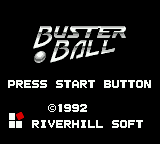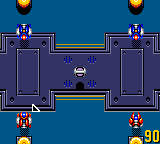Buster Ball
From Sega Retro
| Buster Ball | ||||||||||
|---|---|---|---|---|---|---|---|---|---|---|
| System(s): Sega Game Gear | ||||||||||
| Publisher: Riverhill Soft | ||||||||||
| Developer: Riverhill Soft | ||||||||||
| Peripherals supported: Gear-to-Gear Cable | ||||||||||
| Genre: Action[1][2] | ||||||||||
| Number of players: 1-2 | ||||||||||
|
Buster Ball (バスターボール) is an action and sports game for the Sega Game Gear. It was only released in Japan.
Contents
Gameplay
Buster Ball is a futuristic sports game, similar to Speedball. Gameplay resembles soccer or hockey and uses an overhead perspective. Two teams of robotic hovercraft compete on long fields to try to put a glowing pod-like ball into the opposing team's goal. There are no goalies, so the goals are undefended. The field is divided into multiple sections by impassable electric fences; each team has two players in each section and can only move the ball between the sections by tossing it over. Sections also contain obstacles such as bumpers that repel players and the ball, mines that explode when a player touches them, and thatched areas that speed up or slow down players moving over them. Goals are normally worth one point, but they increase by one point every time the ball rebounds off a bumper (which is indicated by a screen flash).
Games are divided into two halves of 30, 60, or 90 seconds. In the first half, the player one's goal is toward the bottom and player two's goal is toward the top, but this reverses after halftime. At the start of each half, the players are arranged in equal distances around the ball in the middle of the field and compete to gain possession. After a team scores, the players are likewise arranged around the ball in the middle of the field, but the team that did not score starts with its players closer to the ball so they can gain possession easier.
Players are moved in any direction using the D-Pad. Control automatically goes to the player who is closest to the ball.
When the team does not have possession of the ball, players can dash forward with ![]() or
or ![]() . Holding the button and releasing it charges ahead. Charging into another player can be used to gain possession of the ball. The power of the charge depends on how long the button is held before releasing (with the arrow by the player changing color to indicate the power). Moderately powerful charges knock opposing players back, while the most powerful charges temporarily disable the opposing player on impact. The charge also transfers when control transfers to another player.
. Holding the button and releasing it charges ahead. Charging into another player can be used to gain possession of the ball. The power of the charge depends on how long the button is held before releasing (with the arrow by the player changing color to indicate the power). Moderately powerful charges knock opposing players back, while the most powerful charges temporarily disable the opposing player on impact. The charge also transfers when control transfers to another player.
When the team has possession of the ball, players can throw the ball with ![]() or
or ![]() . Holding the button and releasing it throws it farther, depending on how long the button is held. Players on offense cannot dash, so they are encouraged to pass to compensate for having worse mobility than defenders.
. Holding the button and releasing it throws it farther, depending on how long the button is held. Players on offense cannot dash, so they are encouraged to pass to compensate for having worse mobility than defenders.
Modes
There are three modes:
- Open Mode: Plays a single game against a computer opponent or another human with a Gear-to-Gear Cable.
- Buster League: Plays a series of games in a league format, with a password for continuing. Halves are always 60 seconds long in this mode.
- Training Mode: Plays a single game against a computer opponent that initially does not play (until the player scores a goal).
Teams
There are nine different teams, whose names and logos resemble those of Japanese car manufacturers of the time.
| Toyoda | |
|---|---|
| Resembles Toyota. | |
| Nikkan | |
| Resembles Nissan. | |
| Wonda | |
| Resembles Honda. | |
| Nazda | |
| Resembles Mazda. | |
| Misuzu | |
| Resembles Isuzu. | |
| MMG | |
| Resembles Mitsubishi. | |
| Suzuka | |
| Resembles Suzuki. | |
| ダイハク | |
| Resembles Daihatsu. | |
| Sugaru | |
| Resembles Subaru. |
Colosseums
Different colosseums vary in the number of sections and the obstacles that they contain.
- Sapporo
- Sendai
- Tokyo
- Nagoya
- Osaka
- Fukuoka
Versions
Localised names
| Language | Localised Name | English Translation |
|---|---|---|
| Japanese | バスターボール | Buster Ball |
Magazine articles
- Main article: Buster Ball/Magazine articles.
Promotional material
also published in:
- Mega Drive Fan (JP) #25: "February 1992" (1992-01-08)[4]
Physical scans
| Sega Retro Average | ||||||||||||||||||||||||||||||||||||||||||||||||||||||
|---|---|---|---|---|---|---|---|---|---|---|---|---|---|---|---|---|---|---|---|---|---|---|---|---|---|---|---|---|---|---|---|---|---|---|---|---|---|---|---|---|---|---|---|---|---|---|---|---|---|---|---|---|---|---|
|
| 63 | |
|---|---|
| Based on 10 reviews | |
Technical information
ROM dump status
| System | Hash | Size | Build Date | Source | Comments | |||||||||
|---|---|---|---|---|---|---|---|---|---|---|---|---|---|---|
| ? |
|
128kB | Cartridge (JP) |
References
- ↑ File:BusterBall GG JP Box Front.jpg
- ↑ 2.0 2.1 http://sega.jp/fb/segahard/gg/soft_licensee.html (Wayback Machine: 2013-01-01 20:24)
- ↑ Beep! MegaDrive, "April 1992" (JP; 1992-03-07), page 26
- ↑ Mega Drive Fan, "February 1992" (JP; 1992-01-08), page 47
- ↑ Beep! MegaDrive, "April 1992" (JP; 1992-03-07), page 38
- ↑ Consoles +, "Mai 1992" (FR; 1992-0x-xx), page 106
- ↑ Famitsu, "1992-03-27" (JP; 1992-03-13), page 40
- ↑ Hippon Super, "April 1992" (JP; 1992-03-04), page 87
- ↑ Joypad, "Juin 1992" (FR; 1992-05-1x), page 84
- ↑ Joystick, "Mai 1992" (FR; 1992-0x-xx), page 151
- ↑ Sega Pro, "May 1992" (UK; 1992-04-16), page 64
- ↑ Sega Pro, "April 1993" (UK; 1993-03-11), page 74
- ↑ Sega Saturn Magazine, "September 1995" (JP; 1995-08-08), page 88
- ↑ Video Games, "7/92" (DE; 1992-06-24), page 99
| Buster Ball | |
|---|---|
|
Main page | Magazine articles | Reception | |









